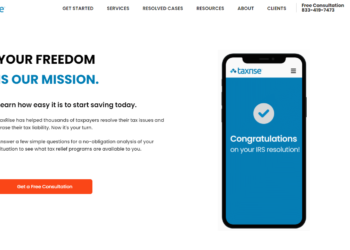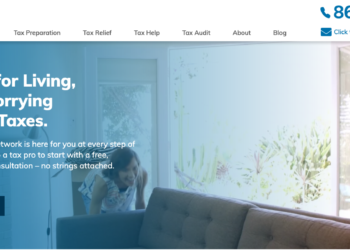Millions of Americans owe the IRS in back taxes, penalties and interest. If you are one of the millions who owe back taxes, it is incredibly important to be proactive with the issue rather than waiting until you are in trouble with the IRS. While learning you have tax debt can be overwhelming, you can easily resolve the debt by following a few simple steps.
Don’t ignore the IRS
The IRS can be brutal and has a wider latitude and more resources to collect than normal debt collectors. IRS collectors aggressively pursue taxes owed.
According to the IRS, if you owe taxes and you don’t respond to the first bill, they’ll send you at least one more. The second bill will include accrued interest and penalties. If you still don’t respond, they’ll begin collection actions.
These actions range from applying your future tax refunds towards your tax debt, to taking your property and assets. If you cooperate rather than ignore the situation, the IRS can help you find a reasonable solution.
It’s important to be proactive and deal with the tax situation head-on. Often people ignore their mail or hide from phone calls but avoidance only makes things much worse.
Tax debt settlement solutions
When it comes to paying off your taxes and negotiating with the IRS, it’s good to know you have options. There are many creative ways to settle tax debts that people may not know about.
Which method you choose depends on your financial situation and how much you owe the IRS. Here are seven options to consider:
1) Pay what you can
If you get a tax bill from the IRS, pay as much as you can as soon as possible. Paying something is better than paying nothing. Partial payments show the IRS that you’re taking the responsibility seriously. Every little bit paid toward the balance also reduces interest charges and penalties.
When paying, the IRS recommends using IRS Direct Pay. It’s free and allows you to pay from your checking or savings. Using this payment gateway also helps guarantee that your payment quickly shows in their system. This could prevent collection action.
2) Pay with alternate funds
You may find that using an alternative source of payment is better than owing the IRS.
If you have a home, consider using a HELOC to pay the IRS. Generally, you can access about 85% of your home’s equity. That amount may be enough to settle your overdue tax bill and get the IRS off your back. HELOCs also feature low interest rates.
Another option for paying your tax bill is to get a personal loan. Some people find that it’s less stressful to use a personal loan to pay the IRS. If you have good credit (700+), you can get a favorable interest rate.
3) Apply for a short-term extension
If you can pay your tax bill in full within 120 days or less, you may qualify for a short-term extension. You can apply online at IRS.gov. Such short-term extensions require no setup fee. You may qualify if you owe less than $100,000 in combined tax, penalties, and interest.
4) Monthly payment plan
You can sign up for the IRS monthly payment plan if you owe $50,000 or less in taxes. This gives you more than 120 days to pay off your tax debt. There is a small setup fee.
5) Offer in compromise
An offer in compromise enables you to settle your tax bill for less than the total amount owed. This route may work if you can show that paying off the entire bill would create a true financial hardship.
The IRS settles for the total amount they think they can collect from each taxpayer. To determine if you qualify for an offer in compromise, the IRS looks at several factors including your ability to pay, income, expenses, and asset equity.
You aren’t eligible for an offer in compromise if you’re in the middle of bankruptcy proceedings. You must also have filed all required tax returns, made all estimated tax payments for the current year, and all required federal tax deposits for the current quarter.
The IRS Fresh Start Initiative introduced in 2012 made the restrictions for an offer in compromise eligibility more flexible. Thanks to the initiative, you now have a better chance of getting an offer in compromise.
Nevertheless, an offer in compromise isn’t an answer for everyone. The IRS determines if you have a good reason for not paying, such as lack of funds or serious illness.
6) First-time penalty abatement
Though it won’t completely clear up your tax debt, you may qualify for a reduction in penalties. Penalties eligible for abatement include failing to file a tax return, not paying on time, and not depositing certain required taxes.
You must prove that you weren’t able to pay your taxes on time because of circumstances beyond your control. If any penalties are reduced, that will also reduce related interest expenses.
7) File for bankruptcy
In some circumstances, you can file for bankruptcy and get rid of back income taxes owed. This applies if you file for Chapter 7 bankruptcy, and there are stipulations.
It only applies to income taxes, the debt must be at least three years old, and you must have filed a tax return. In addition, the debt can’t have been assessed yet, or the debt needs to have been assessed at least 240 days prior to filing for bankruptcy.
Think carefully before filing for bankruptcy to get tax debt forgiveness. The negative consequences of bankruptcy are many, including significantly lowering your credit score.
If your tax debt is several years old, it makes more sense to not file bankruptcy. Generally, there is a 10-year statute of limitations on IRS collections. That means you get IRS tax debt forgiveness after 10 years.
Where to start?
Considering the seriousness of being in tax debt, it’s a good idea to look at various options for getting out of tax debt. The best thing to do is to take action immediately. The longer you wait the more consequences you could face. If you’re not sure how to start or how to negotiate with the IRS, it might be a good idea if you contact a tax professional. Some people can resolve their taxes on their own but to make sure everything is done properly, I would advice to get a hold of a tax relief expert. Unless you’re knowledgeable about the tax code, it’s probably your best bet. You can start by researching and comparing a few tax relief companies. Currently, one of the most trusted companies isTaxRise. Contact an expert and see what your next step should be.



















